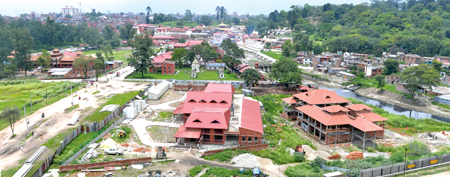Kathmandu’s first electric crematorium will reduce funeral costs, but will have to overcome cultural sensitivities
Ganesh Prasad Dhakal, 48, is dressed in a white dhoti and waits at the cremation site at the banks of the fetid Bagmati at Pashupati for his shift to begin.
When Dhakal moved here from Kavre 30 years ago, this was the only job going, so he started out carrying logs for the pyres. Today, he is one of 28 ‘body-burners’ in the payroll of the Pashupati Aryaghat Service Committee (PASC) to manage the cremations. He earns Rs 1,000 per funeral.

SUNIR PANDEY
“It may seem like a lot, but I have to feed a family of seven back home in Kavre,” says Dhakal. “Initially, I was squeamish about handling corpses but now this is the only work I know.”
Dhakal points at two large brick buildings of the electric crematorium coming up to the south of the Pashupati cremation site and wonders if it will put him out of job. Kathmandu’s first electric crematorium will reduce cost and cremation time, save firewood, and minimise pollution of the Bagmati River.
But there are questions about how culturally acceptable it will be for Nepali families who may be liberal in other ways, but still cling to traditional funeral rituals. Although there are three other holy cremation sites in Kathmandu in Sankhamul, Shobha Bhagwati, and Teku, most people still prefer Pashupati on account of it being one of the holiest Hindu temples. Anyone who dies or is cremated in Pashupati, it is believed, bypasses the purgatory of Baitarni and goes straight to heaven.
“That is why we thought of constructing the crematorium at Pashupati,” says Akrur Singh Mahat, an engineer at the PADT, citing examples from Banaras in India where people shifted gradually from traditional cremations to electric crematoria because they were culturally sensitive.
The new electric crematorium (pic, foregorund) at Pashupati is nearly finished and the electric furnaces are expected in a fortnight. It is composed of two buildings, one of them with an event hall as well as rooms for mourners (pic, left), the other will be a crematorium (pic, right) housing the two furnaces, a ritual hall, and an eye-donation booth operated by the
Tilganga Hospital. The crematorium will have dedicated electric supply and a generator for standby.
“The building will have a hall in which all rituals can be performed,” says Mahat. “After the deceased’s family finishes the rituals, the body is then placed on a trolley for cremation. At the other end of the building, the family may collect the ashes to complete the funeral.”
Since only skilled operators are allowed to run the electric furnaces and none of the current workers at Aryaghat are trained, Dhakal hopes to at least get a job as a gardener or gatekeeper although he will have to take a pay cut.
But for the denizens of Kathmandu, the crematorium will make funerals cheaper and cleaner. It costs up to Rs 10,000 for a traditional firewood cremation, but an electric cremation could cost as little as Rs 2,500 and even this could be reduced if there is a government subsidy.
“We expect most people to ultimately favour the economical electric option, so I think the traditional firewood cremation will remain as a more expensive option to those who want to continue older methods,” explains Shyam Shekhar Jha, director of the Electric Crematorium project.
Surveys by PADT have found that up to 80 per cent of respondents, both Hindu and Buddhist, have reacted positively to electric crematorium and say they will use them if it is cheaper.
On an average, one funeral consumes up to 250kg of firewood and there are an average of 35 cremations a day at Pashupati alone. Most of the firewood comes from a community forest in Dhading and the introduction of the electric crematorium would save more than 9,000 kilos of firewood a day. The electric funerals will also help clean the Bagmati which is severely polluted below Pashupati because ashes of dead, half-burnt wood, clothes of mourners are all ritually thrown into the river.
“Traditional funerals pollute the air and water, and cut down forests. We want to reduce the impact funerals make on the environment, so that is the main aim of introducing electric cremation,” says Jha, adding that there has also been interest for a second crematorium in Devghat, Chitwan.
Read also:
The gift of sight
Curtain call
No dignity in death